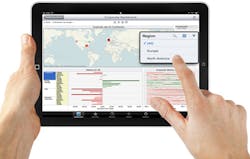Enhanced OEE for Packaging Line Management
Across industry, the factory is increasingly viewed as an asset to be squeezed. Indicative of this viewpoint, “Key aspects of how to evaluate the performance of food and beverage packaging line operations are reduced inventories, lower end-to-end cycle times, and higher asset utilization,” explained Xavier Marfa, Food & Beverage Business Development Manager, Industry Solutions, at Schneider Electric.
“Add to this increasing customer demands for new packaging materials that require more changeovers and faster replenishment cycles, coupled with a general lack of visibility into market supply and demand risks,” and you see a clear need to move toward a culture of empowerment for operations and engineering personnel.
Key to this empowerment, however, is the automation of mundane or manual data collection paperwork tasks, which are often required of packaging line operators, engineers and managers which hurt efficiency and operational agility.
“A typical plant runs 24/7 and manages its own production data with Excel. Simple data collection tools are not linked,” said Wen Jian Lee, Food & Beverage Offer Manager, Industry Solutions at Schneider Electric. “Meanwhile, production volumes are steadily increasing, so people must work faster or more efficiently to fulfill demand. Machine operators, for example, have to handle all the reports associated with production, performance, availability and quality details. This paperwork distracts them from their core machine operating tasks, leading to the recorded data quality being questionable.”
Likewise, production supervisors have to get purchase orders from the ERP system, manually assign orders to lines, and then validate completed orders. Engineers, who should be focused on analyzing and eliminating production losses, have to gather production data from the last 24 hours before doing any analyses. Meanwhile, managers are not getting timely or accurate data from operations and engineering, so as a result, make less–than-optimal or even bad decisions.
“To break this cycle, most companies frame the question as: Should we hire more people or invest in more machines?” noted Lee, who pointed out that a more cost-effective answer lies in managing their production data better.
“Manufacturing packaging lines produce high volumes of data, which means that operators and engineers have to swim through massive amounts of data—often in unstandardized reports—to find the information they need,” Lee said. “But if you have a single platform for data entry and reporting so that the data can be presented in the way users need it, anytime and anywhere, then that changes the whole scenario.”
Lee highlighted how Line Performance Suite—a turnkey OEE solution just launched—is a platform for work order execution and real-time data acquisition that provides visibility into production equipment use as well as enhanced reporting tools for each role in manufacturing packaging line operations.
“Line Performance Suite differs from standard OEE software in that it can drill down into root causes, run reports and analytics on large volumes of data without impacting MES, is model-based driven by operating best practices, and features an open and easy user interface for form creation and modification,” Lee said. “Plus it’s extensible with other Schneider Electric software products. It’s also easy to install and configure because of its model-driven, wizard-based configuration.”
Lee also noted that, although Line Performance Suite features eight pre-defined, standard reports, these reports can be modified as needed. The pre-defined reports are based on Lean Manufacturing/Total Productive Maintenance practices to highlight utilization by timeline and entity, mean time between failures (MTBF), mean time to repair (MTTR), quality, availability, performance, and event analysis.
With Line Performance Suite’s common platform for data entry—which can be automated—information that has to be keyed in manually can be standardized for ease of operator and data consistency. “All data in the software is time sliced, categorized and consolidated by Wonderware Intelligence so that it is ready to be presented appropriately in a variety reports,” Lee said. “This allows operators to focus on production tasks rather than spending so much time on data gathering, cleanup and input.”
For supervisors, Line Performance Suite features automated purchase order handling for central management of work orders. “Data can be viewed on dashboards or in detailed reports,” said Lee, so that supervisors can spend more time focusing on shift coordination optimization.
“Now, every morning, the production manager can meet with everyone and have all the data needed ready for review, with no time spent digging through data,” Lee said. “This means that engineers can spend all day on continuous improvement activities and managers can better focus on strategic decisions to improve factory operations.”
With a model-driven, best practices approach, users can achieve sustainable continuous improvement results. “Because Line Performance Suite is workflow-driven to guide users, changes to improve operations can be embedded into processes to stop faulty practices,” said Lee. “In addition, best practices can be easily shared across factories because Line Performance Suite enables process standardization and governance, which is enhanced by its role-based model that clearly defines how everyone participates in the improvement process.”

